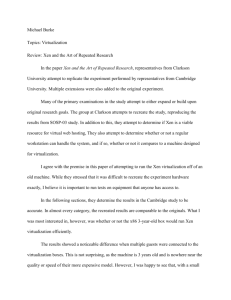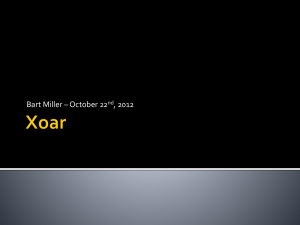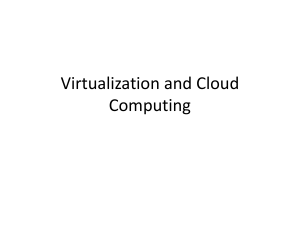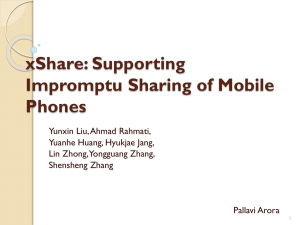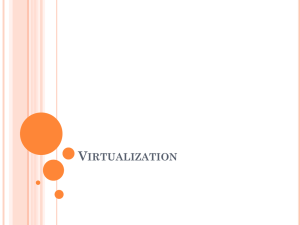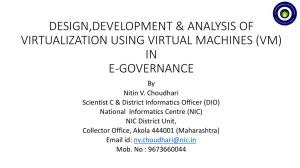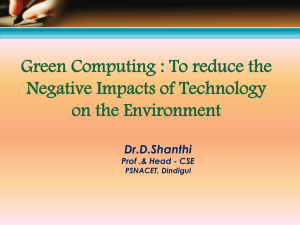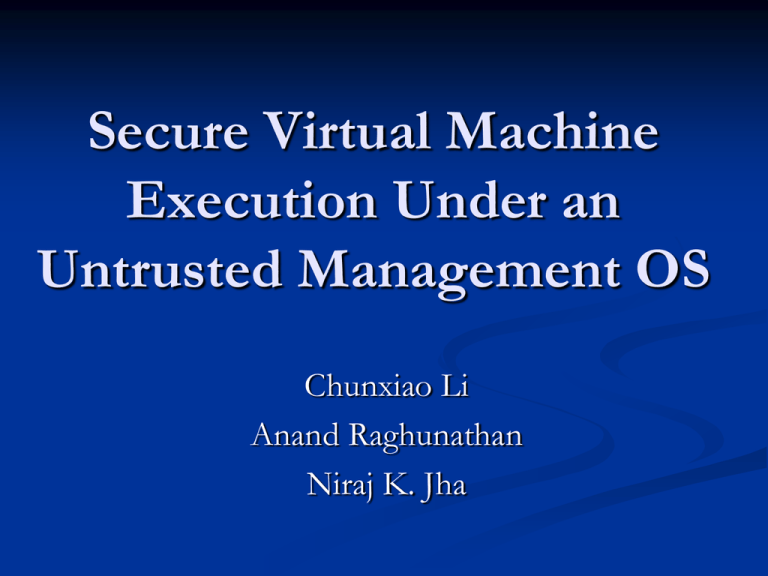
Secure Virtual Machine
Execution Under an
Untrusted Management OS
Chunxiao Li
Anand Raghunathan
Niraj K. Jha
Outline
Background: Security & Virtualization
Security challenges in virtualization-based
architecture
A secure virtual machine execution
environment
Implementation & results
Security analysis
1
The goal of computer security
Computer security: a branch of information
security applied to computers
Three objectives of
information security:
Confidentiality
Integrity
Availability
Confidentiality:
Authentication,
Authorization,
Access control,
Encryption/
Decryption
Integrity:
Data validation,
One-way Hash,
Digital signature
Availability:
Defending DoS,
against DoS,
Back up / restore,
Load balancing
2
What is virtualization?
Virtualization: Technology for creating a software-controlled
environment to allow program execution in it [1]
[1] http://www.ok-labs.com/virtualization-and-security/what-is-virtualization
[2] Barham et al., “Xen and the art of virtualization,” SOSP 2003
3
Relationship between
virtualization and security
On the one hand, virtualization can be utilized to
enhance security
Secure logging (Chen et al., 2001)
Terra architecture (Garfinkel et al., 2003)
On the other hand, virtualization also gives rise to
several security concerns
Scaling, transience, software lifecycle, diversity,
mobility, identity and data lifetime [1]
Virtual machine-based rootkits (VMBR) [2]
[1] Garfinkel et al., “When virtual is harder than real,” HTOS 2005
[2] King et al., “Subvirt: Implementing malware with virtual machines,” IEEE S&P 2006
4
Outline
Background: Security & Virtualization
Security challenges in virtualization-based
architecture
A secure virtual machine execution
environment
Implementation & results
Security analysis
5
Security challenges in
virtualization-based architecture
Our work tries to solve one of the
fundamental security concerns in
virtualization
The trusted computing base of a VM is too
large
6
A Security challenge of
virtualization-based
architecture
Trusted computing base (TCB): a small amount of software and
hardware that security depends on and that we distinguish from a much
larger amount that can misbehave without affecting security [1]
Smaller TCB more security
C
B
A
TCB
[1] Lampson et al., “Authentication in distributed systems: Theory and practice,” ACM TCS 1992
7
A Security challenge of
virtualization-based architecture
(Contd.)
Security challenge : TCB for a VM is too large
Smaller TCB
Actual TCB
8
Xen architecture and the
threat model
Management VM – Dom0
Guest VM – DomU
Dom0 may be malicious
Vulnerabilities
Device drivers
Careless/malicious
administration
Dom0 is in the TCB of DomU because it can access
the memory of DomU, which may cause information
leakage/modification
9
Outline
Background: Security & Virtualization
Security challenges in virtualization-based
architecture
A secure virtual machine execution
environment
Implementation & results
Security analysis
10
Towards a secure execution
environment for DomU
Scenario: A client uses the service of a cloud
computing company to build a remote VM
A secure network interface
A secure secondary storage
A secure run-time environment
Build, save, restore, destroy
11
Towards a secure execution
environment for DomU
(Contd.)
A secure run-time environment is the most fundamental
The first two already have solutions:
Network interface: Transport layer security (TLS)
Secondary storage: Network file system (NFS)
The security mechanism in the first two rely on a secure
run-time environment
All the cryptographic algorithms and security
protocols reside in the run-time environment
12
Domain building
Building process
13
Domain save/restore
14
Domain save/restore
(Contd.)
DomU memory
Page1
Page2
Page3
S Page4
Page5
Dom0
Xen
Layer
Storage
Page3
15
Domain save/restore
(Contd.)
DomU memory
Dom0
Page1
Page2
Page3
3egap
S Page4
$
Page5
Hash
Xen
Layer
W
Hash
Storage
16
Outline
Background: Security & Virtualization
Security challenges in virtualization-based
architecture
A secure virtual machine execution
environment
Implementation & results
Security analysis
17
Implementation & results
Modification of Xen system only affects domain build, save
and restore
Normal work in DomU has little performance degradation
18
Outline
Background: Security & Virtualization
Security challenges in virtualization-based
architecture
A secure virtual machine execution
environment
Implementation & results
Security analysis
19
Security analysis
Malicious Dom0 in original Xen system may:
Access any memory page of DomU and read
its content
Access any memory page of DomU and
change its content
Randomly start and shut down the domain,
and thus control the availability of all VMs
We successfully solved the first two security
concerns, with a small execution time
overhead
20
Outline
Background: Security & Virtualization
Security challenges in virtualization-based
architecture
A secure virtual machine execution
environment
Implementation & results
Security analysis
21
Conclusion
Virtualization technology can both benefit and undermine
computer security in different ways
One of the fundamental security concerns of
virtualization-based architecture is that the TCB of a
VM is too large
A protection mechanism in Xen virtualization system
proposed, which successfully excludes the management
domain out of the TCB with small execution time
overhead
22
Thank you!

